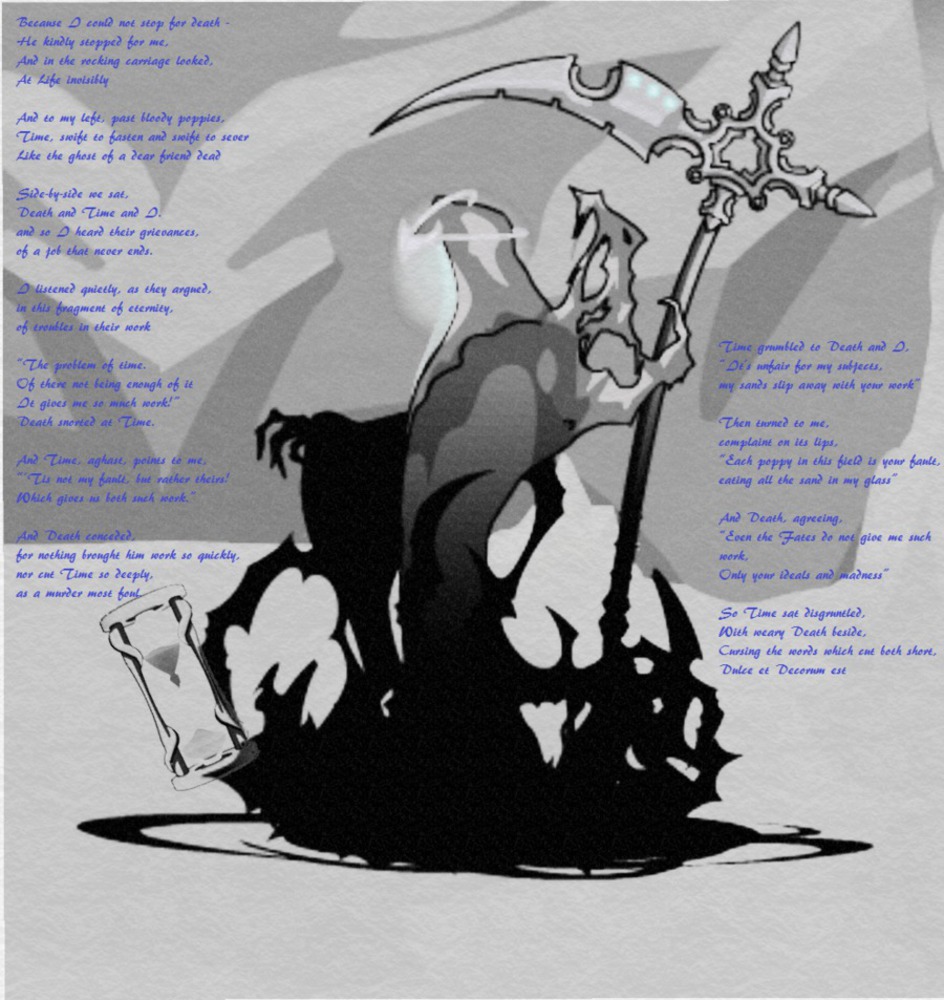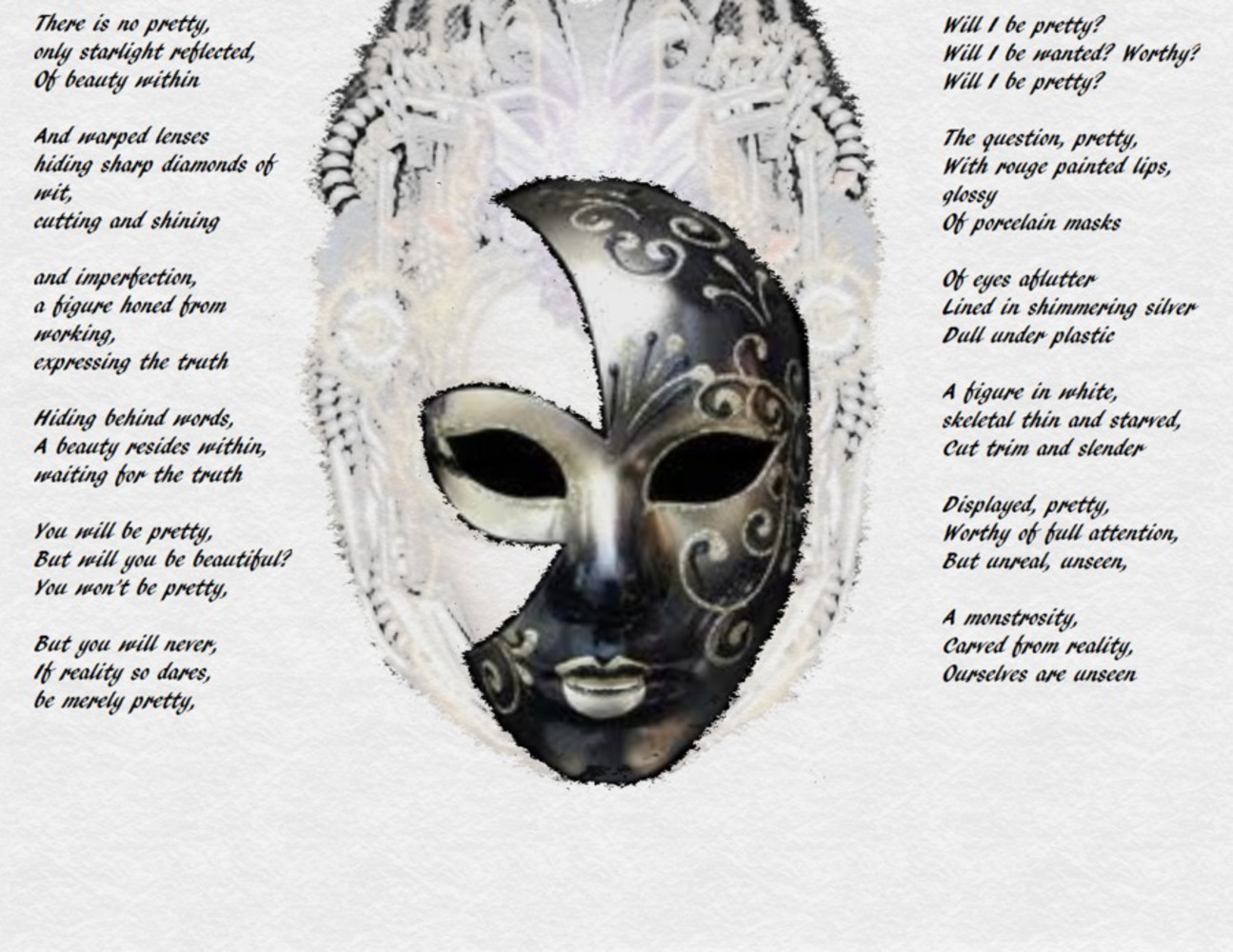Outcome
I originally intended to write a single poem about Death, mostly commentary about how life is often cut too short by war and murder. I picked poetry because I thought, Mary Shelley made illustrated poems, why not? But as I wrote I realized that I can do more than make commentary on dark subject such as death, but also things like beauty and nature. So in the end I wrote a series of poems that used lines from various poems by famous poets to make comments about these topics of Life, Death, Beauty, and Nature.
There are many different types of poems. There are traditional haiku, american haiku, prose, vignettes, diamonds, list, persona poems, free-style and more. I ended up doing a persona, haiku, diamond, and list poem. I drew upon themes of Death and Time, as well as the concepts of Beauty and Nature while relying heavily for some of the poems on previous works. I also used the idea of poems set in pictures, where the poem itself is displayed with a form of illustration.
Picking a poem and subject is easy. Finding the right words and lines to use is quite difficult. I originally had planned for only 1 poem, and that in itself was rather difficult to write. I looked up plenty of poems about Time and a few about Death, and a few about War, but the problem is picking out and using lines from the poems in a way that not only sounds right but also conveys the meaning correctly in an efficient manner.
Developing the poem and its message is a work in progress in itself. Oftentimes I would discuss the poem with a friend only to find that I have already created a new meaning for the poem or another message I want to convey that I then had to change in the poem. Those poems which actual styles, such as diamond or the haiku, I had to really pay attention to wording to convey lines properly with a word or syllable constraint.
For the pictures I borrowed ready-made pictures from other sources and made them into my own by combining different pictures together to make something new, then adding the poems to them.
Life is…
A fading hourglass dripping sand
A field of poppies in full bloom
A string cut too short
unfair
A negotiation between Death and Time
A war
pretty superficial
all about inner beauty
a conflict of values
filled with masks worn and torn
Of bought prettiness, and hidden gems
Cycles upon cycles, neverending
The exchange of moon and sun
- indescribable
1.A Conversation with Death and Time
*Because I could not stop for death -
He kindly stopped for me, *Because I could not stop for Death(Emily Dickenson)
And in the rocking carriage looked,
At Life invisibly
And to my left, past bloody poppies,
*Time, swift to fasten and swift to sever* The Triumph of Time (Algernon Charles Swinburne)
*Like the ghost of a dear friend dead,* Time Long Past (Percy Bysshe Shelley)
Side-by-side we sat,
Death and Time and I.
and so I heard their grievances,
of a job that never ends.
I listened quietly, as they argued,
in this fragment of eternity,
of troubles in their work
“*The problem of time.
Of there not being enough of it* Time Problem (Brenda Hillman)
It gives me so much work!”
Death snorted at Time.
And Time, aghast, points to me,
“‘Tis not my fault, but rather theirs!
Which gives us both such work.”
And Death conceded,
for nothing brought him work so quickly,
nor cut Time so deeply,
as *a murder most foul * Hamlet (I.v.27-28) (William Shakespeare)
Time grumbled to Death and I,
“It’s unfair for my subjects,
my sands slip away with your work”
Then turned to me,
complaint on its lips,
“Each poppy in this field is your fault,
eating all the sand in my glass”
And Death, agreeing,
“Even the Fates do not give me such work,
Only your ideals and madness”
So Time sat disgruntled,
With weary Death beside,
Cursing the words which cut both short,
*Dulce et Decorum est* Dulce et Decorum est, pro patria mori (Wilfred Owen)
I used Paint and Fresh Paint for all of the picture-poems. This is the first poem I made, which is a persona poem where you take on the persona of a recently dead individual, or perhaps the concept of Humanity, and listen to a conversation between Death and Time, both of whom are annoyed with you for giving them so much work from war and murder. I placed the reaper in the center of the picture so that he is centered with the hourglass representing Time, the first thing to be seen. The poem itself is at the sides, in blue so that is stands out from the black and white background.
2.What is Beauty?
*Will I be pretty?
Will I be wanted? Worthy?
Will I be pretty?* Katie Makkai "Pretty"
The question, pretty,
With rouge painted lips, glossy
Of porcelain masks
Of eyes aflutter
Lined in shimmering silver
Dull under plastic
A figure in white,
skeletal thin and starved,
Cut trim and slender
Displayed, pretty,
Worthy of full attention,
But unreal, unseen,
A monstrosity,
Carved from reality,
Ourselves are unseen
There is no pretty,
only starlight reflected,
Of beauty within
And warped lenses
hiding sharp diamonds of wit,
cutting and shining
and imperfection,
a figure honed from working,
expressing the truth
Hiding behind words,
A beauty resides within,
waiting for the truth
You will be pretty,
But will you be beautiful?
You won’t be pretty,
But you will never,
If reality so dares,
be merely pretty,
This poem was based off of Katie Makkai's spoken word poem "Pretty", which basically makes a statement and really criticizes today's expectations of girls and of today's ideas of beauty. I piggybacked on this idea by creating two distinct sets of haikus, the first set describing the kind of consumer, superficial prettiness while the second discusses the hidden beauty of a person's character, rather than appearances. In the picture I separate these two haikus, and to match the Eastern form the haikus are meant to be read from the left to the right, from the top to the bottom. The image is a mask superimposed on a glowing image of a face.
3.Heavenly Bodies
Moon
That Gravity
Which gives life
And illuminates the night
*And if she faintly glimmers* The Moon (Henry David Thoreau
*Stream beloved, flow on, flow on!*To the Moon (Johann Von Goethe)
*And now she turns her perfect face* The moon was but a Chin of Gold (Emily Dickenson)
Guiding diamond stars circling around the everchanging sky
To hide away from the coming dawn
*The Sun-Just touched the morning* The Sun Just Touched the Morning (Emily Dickenson
A cycle which turns forever
As life begins anew
Light and warmth
Bringing the
Sun
This image has the moon at the top, the stars between, and the rising sun near the bottom. The poem is placed in the middle so it can keep its diamond shape while not interfering with the rest of the image. This poem discusses the necessity of the moon and sun for life and their ever turning cycle, while also mentioning the stars in their use as navigational guides.
This set of pieces doesn't really use "readymades" in the sense that I take an iconic image and reuse it for my purposes. I do take images from other people and groups and re-purpose them though, but my main focus is taking lines from famous poets and re-purposing them in my own poems. I think I did a good job of that, but I am unsatisfied with the constraint to doing to with the first and last poems. The first poem I at once liked using lines from other poems because they evoked certain connotations, such as Dulce et Decorum Est, which is a famous war poem where just saying the phrase evokes a dichotomy between proudly dying for glory and country and at the same time the idea of the utter waste of life the idea brings.
However, the lines about Time were especially hard to incorporate, and all of the lines have a specific meter and rhythm to them that had to be worked in a way that didn't result in a discordant verse. And I am still unsatisfied with how the verses fit together. Each verse individually make sense in terms of rhythm and rhyme, but as a whole the effect is quite jarring. While it might seem deliberate, and I might actually try a poem with that kind of effect on purpose, I did not intend for that kind of cringing discordance, though it does fit in with the subject of the poem
I also have a very large problem with Heavenly Bodies, simply for the fact that while it celebrates the cycles of life using the Moon, Stars, and Sun, it is too much like a superficial flowery poem with little meaning. However, I endeavored to incorporate every quote I found that I liked into that poem, and I feel very restricted, despite that fact that truly I am only restricting myself. There is so much potential in the poem that I decided to ignore for the sake of recycling the words of other poets that leaves me feeling unsatisfied.
Reusing art is actually pretty difficult. Sometimes there are meanings associated with the piece used that have to be incorporated and situated well so as not to detract from what I am trying to make. Selecting phrases was also difficult, because they had to work with or fit in with the meaning I wanted to convey. I feel like I restricted myself too much with this type of poem construction. If I were to do this project again, I feel like I would rather take a line from a poem and create a single poem centered around the excerpt, rather than cobble together a few verses from multiple poets into a single poem.
You can upload files of up to 20MB using this form.


